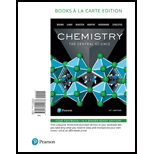
Concept explainers
(a)
To determine: The method of categorization of the sample as acidic or basic.
(a)
Answer to Problem 1DE
Solution: The method of categorization of the sample as acidic or basic is by using litmus paper.
Explanation of Solution
If the solution is acidic, it changes blue litmus paper into red and there is no change in color for red litmus paper.
If the solution is basic it changes red litmus paper into blue and there is no change in color for blue litmus paper.
The sample is categorized as acidic or basic by using litmus paper.
(b)
To determine: The method of categorization of the sample as weak acid or strong acid.
(b)
Answer to Problem 1DE
Solution: The method of categorization of the sample as weak acid or strong acid is titration.
Explanation of Solution
A strong acid and a weak acid can be differentiated by titrating them agianst a strong base like NaOH with the help of two acid-base indicators namely, methyl orange and phenolphthalein. The titre value is noted in both the cases.
When strong acid is titrated agianst a strong base, the same titre value is obtained for both the indicators. For tritration of weak acid and strong base, the color of indicator,methyl orange changes much earlier than the phenolphthalein and two different titre values are obtained.
Thus, the method of categorization of the sample as weak acid or strong acid is titration.
(c)
To determine: The value of
(c)
Answer to Problem 1DE
Solution: The value of
Explanation of Solution
The
The value of
Rearrange the above equation to calculate the value of
The value of
(d)
To determine: The method of separation of salt of weak acid.
(d)
Answer to Problem 1DE
Solution: The method of separation of salt of weak acid is by using the immiscible organic solvent and water.
Explanation of Solution
Weak acids being organic in nature are more soluble in organic solvent.
For the separation of sodium salt of weak acid, the titrated mixture is dissolved in the mixture of immiscible organic solvent and water.
The salt being ionic preferred to dissolved in aqueous layer and weak acid preferred to dissolve in organic layer.
The aqueous layer is separated by separating funnel.
The salt of weak acid is separated by using the immiscible organic solvent and water.
(e)
To determine: The strength of the base and the
(e)
Answer to Problem 1DE
Solution: The strength of the base and the
Explanation of Solution
The strength of a base is determined by comparing
If the value of
The
The value of
Rearrange the above equation to calculate the value of
The strength of the weak base is determined by using
Want to see more full solutions like this?
Chapter 16 Solutions
CHEMISTRY:CENTRAL SCI.(LL)-W/MOD.MASTER
 ChemistryChemistryISBN:9781305957404Author:Steven S. Zumdahl, Susan A. Zumdahl, Donald J. DeCostePublisher:Cengage Learning
ChemistryChemistryISBN:9781305957404Author:Steven S. Zumdahl, Susan A. Zumdahl, Donald J. DeCostePublisher:Cengage Learning ChemistryChemistryISBN:9781259911156Author:Raymond Chang Dr., Jason Overby ProfessorPublisher:McGraw-Hill Education
ChemistryChemistryISBN:9781259911156Author:Raymond Chang Dr., Jason Overby ProfessorPublisher:McGraw-Hill Education Principles of Instrumental AnalysisChemistryISBN:9781305577213Author:Douglas A. Skoog, F. James Holler, Stanley R. CrouchPublisher:Cengage Learning
Principles of Instrumental AnalysisChemistryISBN:9781305577213Author:Douglas A. Skoog, F. James Holler, Stanley R. CrouchPublisher:Cengage Learning Organic ChemistryChemistryISBN:9780078021558Author:Janice Gorzynski Smith Dr.Publisher:McGraw-Hill Education
Organic ChemistryChemistryISBN:9780078021558Author:Janice Gorzynski Smith Dr.Publisher:McGraw-Hill Education Chemistry: Principles and ReactionsChemistryISBN:9781305079373Author:William L. Masterton, Cecile N. HurleyPublisher:Cengage Learning
Chemistry: Principles and ReactionsChemistryISBN:9781305079373Author:William L. Masterton, Cecile N. HurleyPublisher:Cengage Learning Elementary Principles of Chemical Processes, Bind...ChemistryISBN:9781118431221Author:Richard M. Felder, Ronald W. Rousseau, Lisa G. BullardPublisher:WILEY
Elementary Principles of Chemical Processes, Bind...ChemistryISBN:9781118431221Author:Richard M. Felder, Ronald W. Rousseau, Lisa G. BullardPublisher:WILEY





